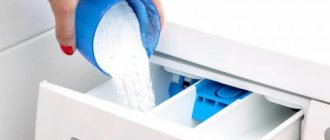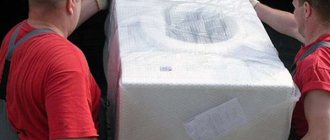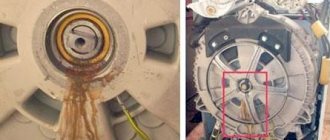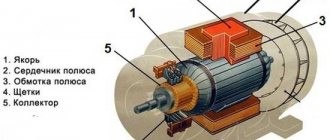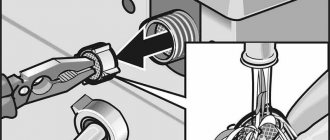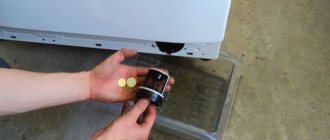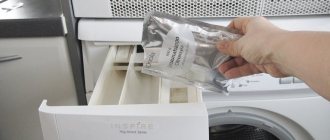Why does a washing machine leave powder in the compartment after washing? Household appliances cost a lot of money. Regular care of the machine will help it work properly for many years.
Sometimes detergent residues suddenly begin to accumulate in the powder compartment. This should be alarming, because the reason for this may be malfunctions of the SMA or its improper operation.
- Causes and fix
- Why does laundry detergent harden?
- Why does air conditioner remain in the tray?
- Expert advice
- Catalog of washing machines with reviews
Online diagnostics of a washing machine
If your machine stops washing or rinsing clothes normally, then some kind of malfunction or breakdown has occurred.
You can try to find the problem yourself. Run diagnostics
Select which operation your washing machine does not perform:
1. Doesn’t drain 2. Doesn’t rotate the drum 3. Doesn’t spin clothes 4. Noises, knocks, buzzes when spinning 5. Doesn’t turn on
Checking the operation of the drain pump Is the drain pump of the washing machine working? Yes No I don’t know << Back
Clogged hoses in the washing machine If the sound corresponds to the normal sound that has always been observed when the device is working, the cause is probably a clog.
Was there a blockage in the drain hose? Yes
<< Back
The drain pump does not work! If the sound matches the normal sound of the drain pump, it is recommended that you check the drain filter first.
After cleaning, does the drain pump work and does the washing machine drain water? Not really
<< Back
Operation of the drain pump The sound of the pump is usually immediately audible and noticeable. If there is no sound, the pump is not working. We are looking for how to separately enable the water drainage program. As a rule, this is a separate option. After the program has been turned on, the pump should start working in 1-3 seconds. If everything is done correctly and the pump is operational, a buzzing sound will appear. If you hear no buzzing or other sounds when you turn on the program, the pump is probably faulty.
Is the washing machine drain pump working? Not really
<< Back
Clogged car hoses If you have identified a clog in the hoses, you need to disassemble them, clean them, and then reassemble everything.
Does the washing machine drain well? Not really
<< Back
Hurray, you did a great job, you fixed it.
<< Return to the beginning of diagnostics
The drain pump is faulty, call a professional.
<< Return to the beginning of the diagnosis.
The washing machine does not rotate the drum. During the operation of the washing machine, such a problem may occur. Each model has a different drum operation. It rotates according to a given algorithm, which is set by the program. This principle applies to spinning and washing. If you are not sure whether the drum is not spinning or whether it is working, put the laundry in the washing machine. Start the spin program. If the machine is running, it will first drain the water and then start spinning. In this case, a rotational process will be observed. If rotation is not visible, then check the belt. First, turn off the program, then unplug the wire from the outlet so that power does not flow into the device. Now you need to remove the back cover. You will need to carefully inspect the drum belt. It is quite easy to determine whether it is in the wrong position or damaged.
Is the washing machine belt torn or stretched? Not really
<< Back
Broken drum drive belt If the belt breaks, it will be immediately visible. There are also often cases when the belt simply stretches, which is why the drum, accordingly, does not rotate. Do not allow the machine to operate if the belt breaks. It is important to check whether it has wound around the engine pulley or broken the wiring to the engine. The heating element and temperature sensor may also be damaged if the belt does catch the wires. It is imperative to ensure that the belt model is original. If you choose an unsuitable or low-quality product, this will affect the performance of other devices. How do you know what kind of belt you have? There will be a marking written on the old one, compare it with the one indicated on the belt offered to you. You can also find out belt information by car model.
<< Return to the beginning of the diagnosis.
Washing machine motor malfunction If a malfunction is not found, the block with wires must be disconnected from the electric motor. Carefully remove it. We visually evaluate the engine. It may have melting, cracks, or other effects that clearly indicate damage. We call the windings of the tachogenerator and the engine. It is important to understand that you can fully study how correctly the engine operates and whether there is a malfunction only at the stand. If rotation does not occur, there may be a problem with more than just the motor. Sometimes the cause is a malfunctioning electronic module. If a short circuit occurs in the engine, the module could be damaged, while the engine remains operational. Also, the wires could be damaged.
<< Return to the beginning of the diagnosis.
Repairing a washing machine that does not spin clothes After completing the washing process, the washing machine may not spin properly or may not start spinning. Firstly, look, perhaps another mode is set, which does not involve turning on the spin cycle at all. This happens, for example, with programs related to washing woolen items and delicate fabrics. To check, run the spin cycle separately. If the washing machine does not drain water, we proceed to check the pump.
Does the washing machine now spin clothes? Not really
<< Back
Congratulations, you have solved your problem!
<< Return to the beginning of the diagnosis.
Repair of washing machines, imbalance Modern washing machines place the laundry on the drum before spinning. This is necessary for quality work. Check if this feature works. Sometimes a situation occurs when things get wrapped up in a ball that cannot be unwound automatically within a certain time. At this point the work stops. You need to unwind this laundry yourself, lay it out and continue operating the washing machine. In this case, it is important to turn off the machine, and then, when the laundry is laid out, turn on a separate spin program.
Does the washing machine now spin clothes? Not really
<< Back
Washing machine repair, drum drive repair Now you need to check the drum drive belt. We remove the cover and visually assess the condition of the belt. There should be no damage. If the tension is weak, the spin may not turn on. If you need to replace the belt, you should only replace it with the original one. After replacing, we try the program again.
Fault found, does the washing machine spin? Not really
<< Back
The engine or electronic module is faulty, call a repairman to your home.
<< Return to the beginning of the diagnosis.
The washing machine hums, makes noise during the spin cycle, rumbles, and makes a jet plane noise. If the washing machine makes noise during operation, making unusual sounds, it’s time to pay special attention to it. In this case, a visible breakdown or lack of functionality may not be observed, but the appearance of strange sounds indicates that it is time to look for a malfunction. It is important to understand that a new car that has just been delivered should be inspected for shipping bolts. If you forget to remove them, noise and vibration are inevitable. So, let's begin! We turn the washing machine drum and listen to extraneous sounds.
When rotating, do you hear extraneous noise, hum, balls rolling, does the drum move unevenly with slight jamming? Not really
<< Back
If the drum rotates and uncharacteristic sounds appear, including vibration, it’s time to check the bearings. If they malfunction, they will have to be replaced.
<< Return to the beginning of the diagnosis.
The counterweight of the washing machine has come loose. The fastening of the counterweights must also be of high quality. If they are “loose”, it’s time to eliminate this defect. In some cases, you can notice that the bolts that secure the stones are completely missing. In this case, the connectors for mounting will be visible. The bolts need to be found and put in place - they probably simply came loose. A rumble heard while the washing machine is operating may indicate that the bolts have partially loosened. To check the bolts, you can simply push the drum. If it is secure, the bolts are fine. If it moves, there is a defect.
Do you hear any noise, clanging or rattling noises when moving the washing machine tub? Not really
<< Back
The counterweight has come off
<< Return to the beginning of diagnostics
Checking the shock absorbers of the washing machine Checking the shock absorbers. If you hear vibration or excessive noise during the spin cycle, there may be a problem with the shock absorbers. Sometimes the washer moves. Now let's check the functionality. Remove the top cover. Click on the tank, move it five to seven centimeters down. A normal reaction will be observed if the tank rises sharply, jumping a little and stopping in its normal place. If this does not happen, the shock absorbers need to be replaced.
Are the shock absorbers of the washing machine working? Not really
<< Back
If a visible defect has not been identified, check whether a foreign object may have entered the machine. Replacing shock absorbers. The problem with shock absorbers wearing out occurs quite often over time.
<< Return to the beginning of the diagnosis.
Replacing washing machine shock absorbers. Malfunction and wear of shock absorbers is a fairly common phenomenon.
<< Return to the beginning of the diagnosis.
The washing machine does not turn on. It is worth trying to find the cause of the problem yourself and fix it. We start by connecting the device to the network. Next, click on the “network” button. In different car models, different indications are triggered: here either the display will start working, or, on the contrary, some other button.
Does the washing machine have an indicator? Not really
<< Back
Hatch lock lock (UBL) You can check it by turning on any of the programs. We choose what we will use. Click on the corresponding button. Don't forget to pay attention to the inclusion. As a rule, the process of activating a function is characterized by the presence of a certain sound, for example a click, with which the device makes it clear that pressing again is not necessary and the machine is already working. If there is no sound, the button may be broken. In this case, the main thing that must be done is to block the hatch and start working. If this happens, everything is fine.
The washing machine is blocking the hatch and the UBL is triggered? Not really
<< Back
Water fill valve malfunction
<< Return to the beginning of the diagnosis.
The washing machine hatch does not lock
<< Return to the beginning of the diagnosis.
No indication Checking the electrical circuit. If you notice that the washing machine does not respond to being turned on, it is first recommended to check the power supply. The outlet may be faulty. Try connecting another device. If the outlet works, you need to check whether the circuit that conducts energy through the washing machine from one element to another is intact. To do this, you will need a multimeter, which will help you fully analyze the ability to respond to an electrical signal at several stages of operation. If there is no network connection anywhere, this is probably the problem. We carry out this manipulation until we reach the electronic module. If we are talking about an old washing machine, here it will look like the device’s program. When you turn on the button, there should be no breaks in the circuit. If the circuit works, everything is fine electrically.
Is the washing machine's power supply OK? Not really
<< Back
Repair of electronic module (unit)
<< Return to the beginning of diagnostics
Contact circuit fault
<< Return to the beginning of diagnostics
Incorrect water supply
Often the powder remains unused due to pressure problems in the pipe. You need to check whether the water is supplied with sufficient pressure.
To do this, you need to open the mixer tap and watch the stream. If it is clear that the pressure is weak, this will be the reason for the powder not being washed out; the water is not strong enough to wash out all the granules.
In this case, the problem is not with the washing machine, but with the water supply organization, which is obliged to supply water to homes under a certain pressure. The minimum pressure required for operation can be found in the washing machine data sheet.
Remains of powder in the tray
If the pressure is not strong, you need to check the supply valve. Sometimes it happens that it is not fully open and water enters the compartment very slowly. In this case, it is enough to open the machine tap all the way.
Powder problems
Fake synthetic detergents can harm not only the washing machine, but also human health.
Low-quality powders pose the same danger. Due to its composition, water does not wash the granules out of the dispenser. Such products, unable to properly clean laundry, can cause allergies in humans. The problem is easily resolved by changing the brand of powder.
Expert opinion
I work in the household appliance repair industry. Extensive experience in restoring washing machines and dishwashers.
Ask a Question
Even high-quality detergent will not be completely washed out of the dispenser if you add more than normal. You should always follow the recommendations indicated on the packaging of the powder and use a measuring spoon or glass.
Clogged fill valves or filter
take out the valve filter
Residents of many regions suffer from poor-quality tap water. It is harmful to health and quickly damages household appliances, especially washing machines. The filter on the inlet valves should be checked monthly and washed under running water.
You can do this yourself by unscrewing the inlet hose from the back of the machine and carefully pulling out the filter using pliers. Or use the services of masters.
Important! The water supply must be shut off!
Pipe branch
A clogged drain pipe may render the machine unusable. Undissolved powder granules gradually clog it, and as a result, the equipment does not cope with its task and may fail completely.
It is better to entrust cleaning the pipe to professional craftsmen; this is not an easy job. If the part is damaged at the slightest level, you will have to throw it away and purchase a new one.
It connects the tray to the tank. To get to the pipe, you need to partially disassemble the washing machine.
The pipe, which is located between the tank and the tray
Why does laundry detergent harden?
Hardened powder in the tray looks unpleasant. A musty smell, mold - that’s what will happen if you don’t find the cause of hardening in time. There are several reasons why the product petrifies:
- the use of detergent powder that is not suitable for washing in an automatic machine;
- the powder was not stored in compliance with the rules of permissible humidity. Due to exceeding the indicators, it cakes and does not dissolve;
- problems with water pressure;
The powder tray should be washed regularly. To do this, you need to remove it from the machine and clean it under hot water with a sponge and detergent. Then wipe thoroughly and dry.
It is advisable to carry out such cleaning 2 times a month. Most models are available with a removable powder receptacle. Otherwise, the compartment must be thoroughly rinsed without removing it, and then left open for several hours to dry.
Expert opinion
I work in the household appliance repair industry. Extensive experience in restoring washing machines and dishwashers.
Ask a Question
If the fossilized powder has already become moldy, after removing it, the compartment should be cleaned with soda. It will eliminate the unpleasant odor and disinfect the plastic. For cleansing purposes, you can use citric acid. It is poured into the powder compartment and the washing cycle is started, setting the temperature to 60°.
When residues have not been cleaned for a long time, the use of strong detergents may be necessary. In this case, the tray is soaked in the solution for 10-15 minutes and then washed under running water.
We take out the tray
What are the reasons why the washing machine does not pick up all the powder?
There may also be several of them. It is possible to cope with them on your own, or at least make the consequences less tragic. So:
- Insufficient water pressure in the water pipe. A characteristic sign of this is that the machine takes a very long time to pour water to the required cutoff. This is a reason beyond your control, so it is difficult to cope with. If you constantly have low water pressure, then in this case you can try using washing gels rather than powders.
The water supply valve is not fully open. Check and open.
The powder feed tray is clogged. Over time, the washing powder gradually adhered to the back wall of the drawer and blocked the outlet. Periodically, it is necessary to pull out the tray and wash it so that the adhering powder does not interfere with the supply of a new portion inside, and after finishing washing, leave it pulled out to dry.
Overdose of washing powder. A large amount of washing powder or fabric softener, so the water does not have time to wash them off completely. Follow the instructions printed on the powder packets and try not to exceed the recommended dose.
Poor quality washing powder. Cheap synthetic detergents containing large amounts of soda ash may not be easily wetted with water or may clump. A blockage forms. Because of this, they are poorly washed out of the compartment. Replace it with your regular powder and see: maybe everything will return to normal.
Why does air conditioner remain in the tray?
Another common problem is conditioner that does not rinse out of the tray intended for it. A persistent smell of powder remains on the linen, but this will alert the rare housewife.
There are several reasons why the air conditioner does not flush out of the tray, some of them are easy to fix, while others will require the intervention of a professional to solve. The air conditioner may not be used in the following cases:
- liquid is poured into another compartment. Then, you need to clean it of the conditioner, wash it, wipe it dry and be more careful next time;
- The air conditioner flush channel is clogged. Often a substance collects in the canal, which prevents new portions of fluid from passing through. In this case, it must be cleaned by rinsing it under water. This procedure must be performed after each wash;
- Regular use of excessive amounts of conditioner. Don’t assume that adding more liquid than necessary, you will get fragrant laundry and will not cause any harm to the machine. Excess product will not come out of the flushing channel, then it will dry there, forming an obstacle to new portions. It will take more than one rinse under running water to get rid of the dried substance. Always follow the dosage indicated on the package;
- using low-grade or expired air conditioner. Expired product often turns into a sticky mass that even good water pressure cannot wash off. Fake, low-quality air conditioners have the same problem. Always check the expiration date of the product, give preference to well-known manufacturers.
- water enters under low pressure. This happens in two cases: the valve is not fully open, problems with pressure in the water pipes.
The above reasons are easy to eliminate yourself. But there are also some that require a specialist to solve. These include:
- filter clogged. In this case, the air conditioner will flow into the drum of the machine, but not completely. Washing the filter will solve this problem, which arises due to the use of water contaminated with various impurities;
- The mechanism for supplying water to the compartment is faulty. As a rule, the cause is a broken or jammed steering cable.
Why does detergent remain in the washing machine tray after finishing the wash: solving the problem
If the detergent has not completely dissolved and there is residue left in the container, you should:
- Initially, make sure that the water pressure is sufficient for full operation of the equipment, and that the inlet valve is fully open. Low pressure can occur due to the simultaneous use of water in other rooms (kitchen, toilet, bathroom).
- Check the quality of the powder by dissolving a little in a bowl (if there is any insoluble residue). Check the amount of detergent loaded into the tray by reading the instructions for the household appliance.
- Determine whether the compartment for pouring powder is selected correctly.
The cause of the problem may be debris clogged in the filter mesh.
To clean it, you need:
- Close the inlet valve and turn off the power to the washing machine.
- Disconnect the hose from the housing.
- Using tweezers and pliers, remove the filter mesh.
- Wash and, if necessary, soak in vinegar or citric acid.
- Install the system in place.
In addition, you must:
- Check the operation of the intake valve; if it is damaged, replace it with a new one.
- Inspect the pipes and hoses supplying water to the container with the detergent composition. If clogged, remove them, rinse, and clean mechanically.
- Rinse the powder container itself, in which indelible residue is found.
- Check the water drain and remove the blockage if necessary.
Be sure to read:
When spinning, the drum knocks loudly: causes of vibration and rumble in the washing machine, how to fix it
Incorrect water supply
The problem with insoluble residue may arise due to incorrect operation of the system supplying water to household appliances.
Causes:
- low pressure in the central water supply pipes;
- the hose through which water is supplied is compressed or bent;
- the mesh filter is faulty.
The instructions for the washing machine indicate what length the inlet hose should be. A longer hose, installed independently, can reduce the water pressure, which will inevitably lead to deposits in the tray.
Another reason is poor-quality water flowing from the tap into the device’s drum. In the thin hose through which water is supplied to the tray with powder, limescale and scale may form due to the high temperature when heated, which automatically reduces the pressure.
Powder problems
The right approach to choosing a washing powder will help avoid problems. An inexpensive counterfeit product may contain a huge amount of insoluble compounds that can clog the detergent compartment. When washing, you should use household chemicals of well-known brands.
Using a measuring cup or spoon will also help avoid the problem. The amount of powder for each mode is specified in detail in the instructions.
Drain clogged
An unpleasant odor emanating from the drain pipe, the presence of mold and black spots on it may indicate a clogged drain. A clogged drain pipe automatically leads to problems with dissolving granules. In this case, cleaning the entire drain system cannot be avoided.
Expert advice
To prevent detergent and conditioner from accumulating and causing damage to household appliances, you need to follow simple recommendations:
- always use high-quality detergents (powders, gels) and conditioners;
- check the expiration date of the products used;
- regularly wash and dry the powder and conditioner compartments;
- check the degree of opening of the water supply filter;
- add products within the recommendations specified by the manufacturers on the packaging;
- keep the drain and pipe in the washing machine clean;
- choose the right programs.
When you notice that detergent or conditioner remains in the cell, this is a sign that you need to carefully inspect the machine and clean the dirty parts that need it. If the equipment is in perfect order, then the problem is in the washing powder. In any case, you should not leave this problem unresolved, as this may lead to breakdown.
Video
Reasons why the washing machine does not wash out the powder at all
If this happened to a new washing machine, first read the instruction manual and see if you did everything correctly? Because the most common reasons that the washing powder remains untouched and the rinse aid is in place are:
- Washing powder is poured into the wrong compartment. For example, instead of a compartment for regular washing, the powder is poured into a cuvette for preliminary washing.
Water does not flow due to a closed valve. Check and if this is the case, then simply open the valve all the way.
The water supply is turned off. In this case, all that remains is to wait for the water supply to resume.


